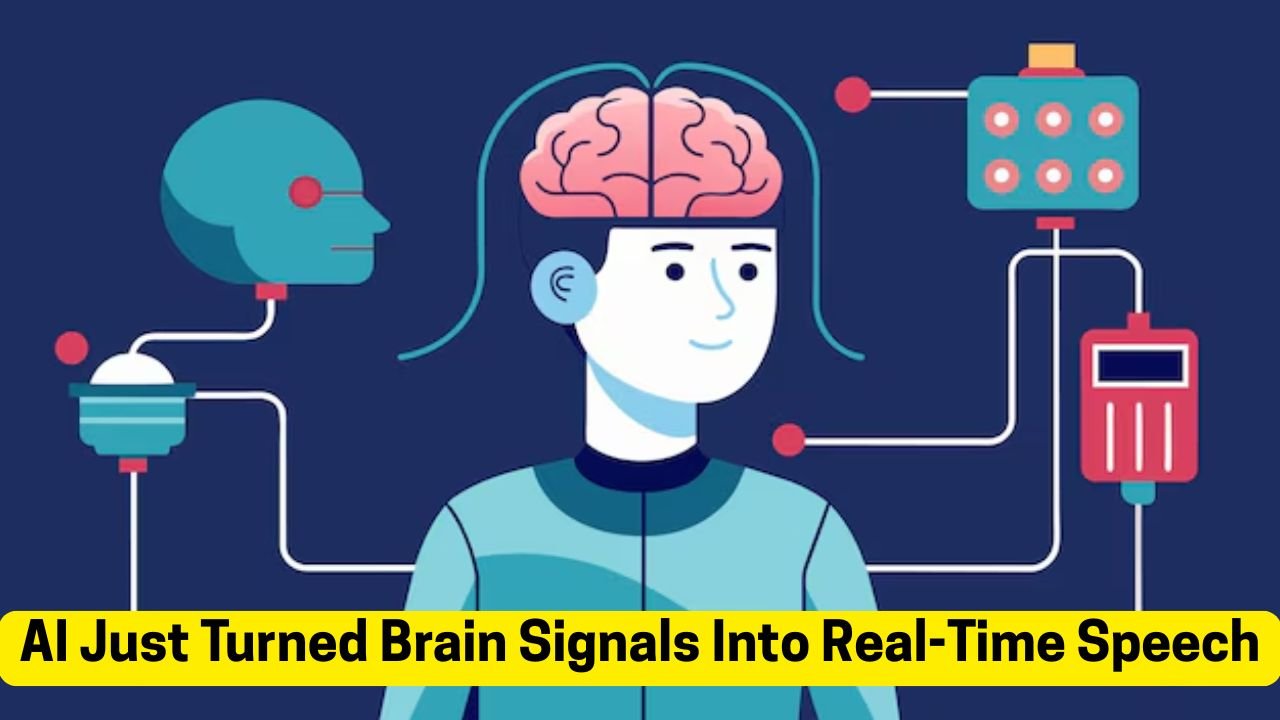Alright, imagine this: someone hasn’t spoken in 18 years. Not a single word. Not even a whisper. Then, one day, they try to speak in their mind… and a computer says it out loud for them.
Sounds like a scene from a sci-fi movie, right? But nope — this is 100% real. Researchers just made it possible to turn brain signals into real-time speech using AI.
Let’s sit down and unpack this amazing story together — no tech degree needed. Just curiosity. ☕
So, What Actually Happened?
This breakthrough comes from scientists at UC Berkeley and UCSF. They’ve been working on a brain-computer interface — or BCI for short — that lets your brain “talk” directly to a machine.
Now, before we get lost in the fancy terms, here’s what you need to know:
The system listens to the brain’s speech signals and turns them into real words. Spoken out loud. As you’re thinking them.
Seriously. It’s that wild.
Meet the Woman Who Inspired It All
Let’s talk about the woman at the center of this milestone. She’s 47 and had a stroke nearly two decades ago that left her unable to speak.
For 18 years, her thoughts were locked inside — until researchers implanted a small array of electrodes into her brain. These picked up signals whenever she tried to say something in her mind.
And here’s the magical part: the AI learned to understand those signals and translated them into sentences. The system even spoke them out loud, using a synthetic voice that was modeled to sound like her own.
Can you imagine hearing your own voice again after almost two decades? That moment must have been indescribable.
Wait, So How Does the System Actually Work?
Let’s break it down together:
- Brain Signals: When you think about speaking, even if you don’t move your mouth, your brain still fires off signals.
- Electrode Array: These are tiny sensors placed on the part of the brain that controls speaking (the motor cortex). They catch those thought-signals.
- AI Decoder: This clever bit of software deciphers what those signals likely meant. “Was she thinking of saying ‘Hello’? Or ‘I’m tired’?”
- Speech Synthesizer: Once the AI figures it out, it speaks the sentence out loud using a computer-generated voice.
All of this happens in under a second. That’s quicker than most people can open their mouths to reply.
Can It Really Speak That Fast?
Yes! In some tests, the system generated speech at 70–80 words per minute. For context, that’s pretty close to how fast we speak naturally.
And unlike older systems where you’d have to type letter by letter with your eyes (imagine how slow that is), this one is super fluid and expressive. Conversations don’t feel robotic anymore — they feel like… conversations.
Here’s a Quick Look at the Stats:
| Feature | Current Status |
|---|---|
| Real-time Speech Output | ✅ Yep, under 1 second |
| Speaking Speed | ~78 words per minute |
| Personalized Voice | ✅ Sounds like user |
| Accuracy | ~75% right now |
| Requires Brain Surgery | ✅ For now |
| Everyday Use? | ❌ Not yet |
Why Is This Such a Big Deal?
Let’s get real for a sec. If you’ve ever lost your voice even for a day, you know how frustrating it can be. Now imagine not being able to speak for years — or ever.
This tech gives people the ability to:
- Express needs and feelings
- Reconnect with loved ones
- Be part of conversations again
It’s more than just talking. It’s about dignity, independence, and human connection.
But… Is It Safe?
Great question. Right now, the system does require surgery to implant the electrodes, so it’s not something you can just pick up at your local electronics store.
Plus, it needs to be trained specifically for each user — the AI has to learn your brain’s unique “language.” But scientists are working on making it faster, easier, and hopefully, one day, less invasive.
In the future, they’re hoping to use external sensors (like wearable EEG headsets) instead of implants. So, fingers crossed!
What Could Happen Next?
Glad you asked! Here are a few exciting possibilities:
- Portable Devices: Imagine a sleek headset or glasses that connect with your phone or smart speaker.
- Multilingual AI: Speaking in more than one language? The AI could decode that too.
- No More Guessing Games: Nurses and caregivers wouldn’t have to guess what someone wants or needs.
- More Personalized Voices: Each person gets their own unique sound, not a one-size-fits-all robot voice.
Basically, it’s not just a voice — it’s a second chance at communication.
A Quick Thought 💬
You know what’s amazing? This isn’t just about technology. It’s about giving someone their life back.
The ability to say “I’m okay,” or “I love you,” or “I’m in pain” — that’s powerful. And if AI can help make that happen, then maybe it’s not as scary as movies make it seem, right?
Let’s Wrap It Up
So yep, it’s true — AI just helped a woman speak again by turning her brain signals into real-time speech. It’s not perfect yet, and it’s still early days, but it’s already giving people a new way to connect with the world.
Next time you hear someone say “AI is taking over,” you can tell them: “Actually, it’s giving people their voice back.” ❤️

